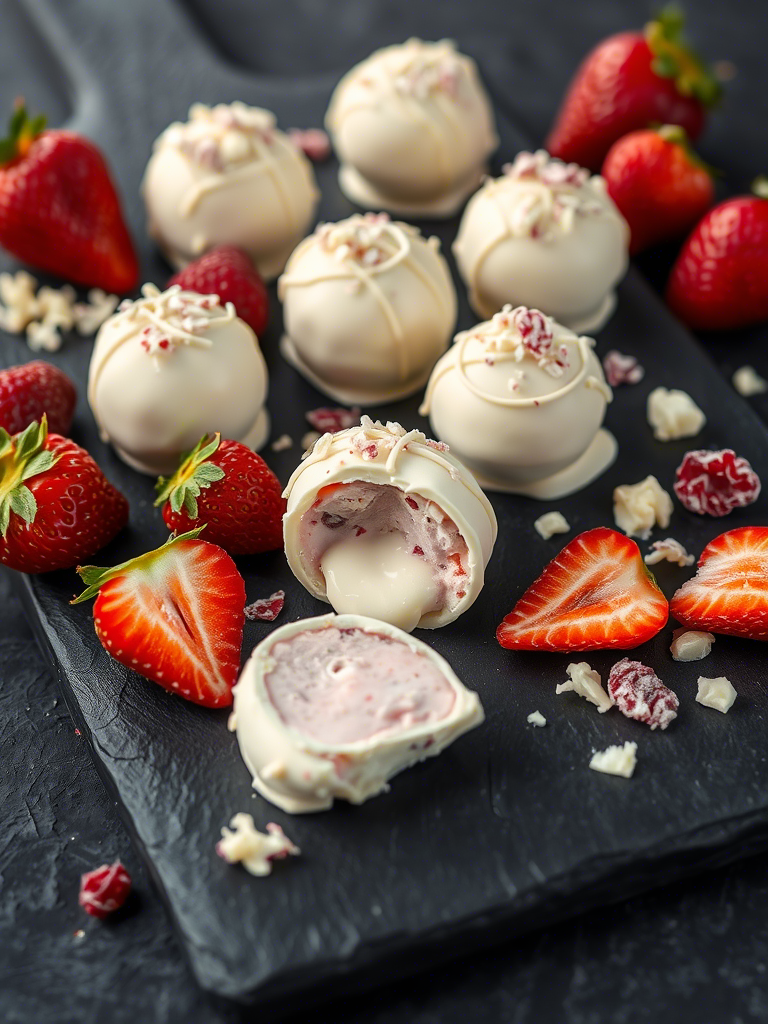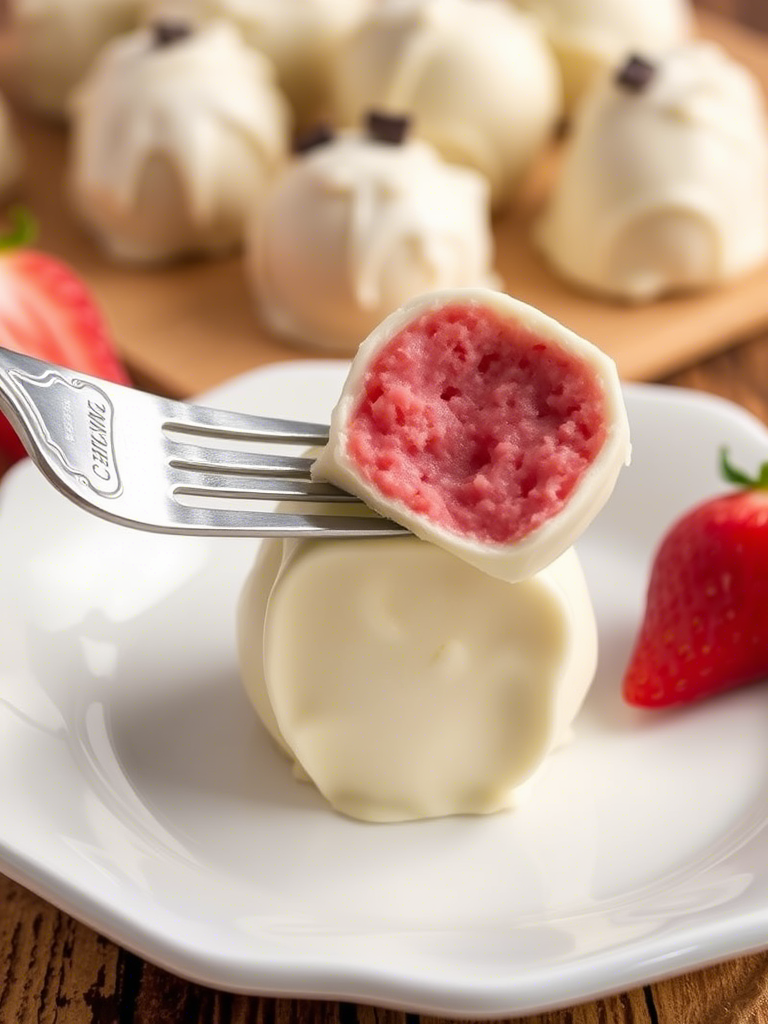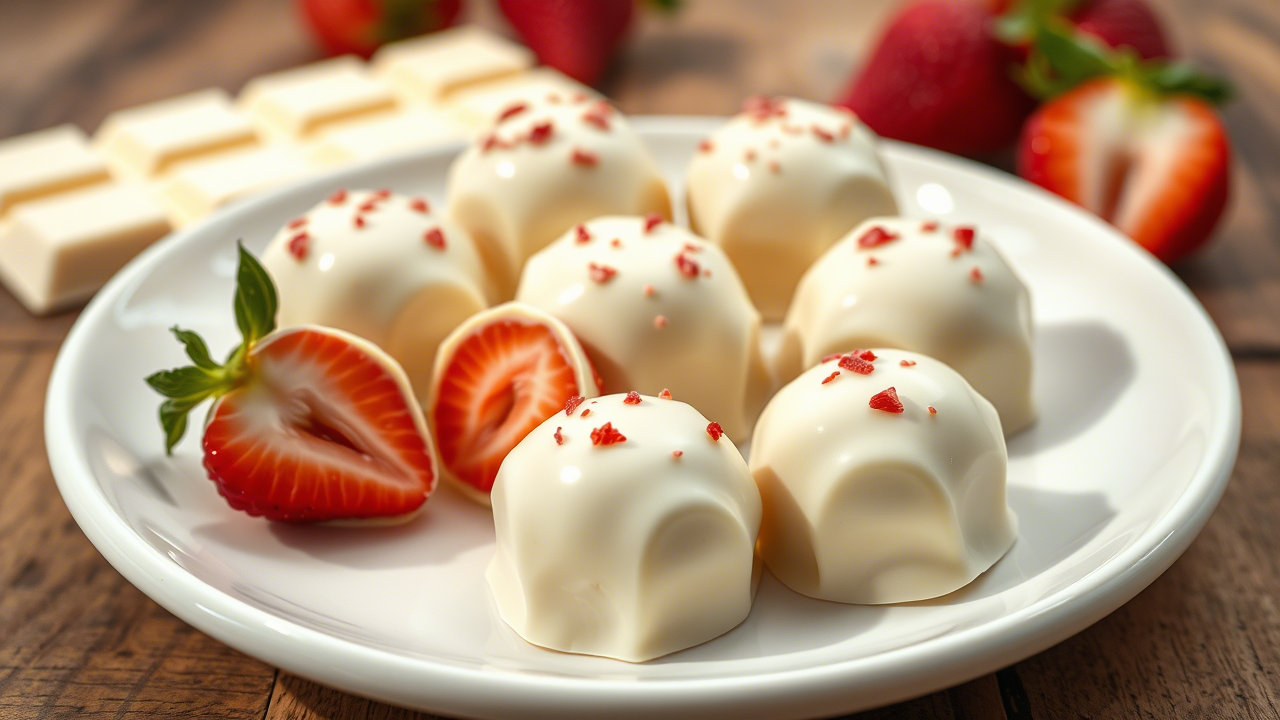Strawberries and white chocolate don’t just get along. They flirt. They seduce. And when you put them together in a silky, melt-on-your-tongue truffle—well, it’s not just dessert anymore. It’s a statement. In this article, we’re unpacking what it really takes to make world-class white chocolate strawberry truffles. This isn’t a Pinterest fantasy; this is culinary engineering. From ingredient selection to tempering precision, we’ll walk through the professional-grade decisions that separate amateur from artisan.
You probably already know what a truffle is, or think you do. But to a professional chocolatier, that term means one thing: perfect texture, balanced sweetness, and chemistry so fine-tuned it almost feels accidental. Spoiler: it isn’t. Let’s dig into what makes these truffles tick.
The Flavor Matrix: Why White Chocolate and Strawberry Work
White chocolate is often misunderstood. It’s not technically chocolate, since it lacks cocoa solids. But it does have cocoa butter, milk solids, sugar—and a very specific kind of fat matrix that affects melt, mouthfeel, and flavor carry. It’s a blank canvas with body. That matters.
Strawberry, meanwhile, is high in esters and volatile compounds like ethyl butanoate and methyl anthranilate. These compounds are fat-soluble and explode when paired with cocoa butter. Fresh strawberries? They’re about 90% water, which is a problem. That water messes with the emulsion. We’ll fix that later.
There’s science behind the pairing. Research from the Journal of Agricultural and Food Chemistry (2018) shows that white chocolate enhances fruit volatiles up to 35% more than milk or dark chocolate, especially in controlled fat-rich matrices. It’s not luck—it’s chemistry.
Ingredient Selection: No, You Can’t Use Grocery Store Chocolate
Most supermarket white chocolate is garbage. Sorry, but it’s true. It’s full of stabilizers, palm oil, waxes—stuff that ruins your truffle’s texture and flavor release. If you’re in the business of flavor, you need couverture.
Look for cocoa butter content above 30%. Valrhona Ivoire, Callebaut W2, or Cacao Barry Zéphyr are industry standards. They melt smooth, hold emulsions better, and temper reliably.
Strawberries? Freeze-dried is your secret weapon. It solves the water problem and concentrates the flavor. A 2020 sensory study from the University of Copenhagen found that freeze-dried berries retain 89% of their aromatic profile, compared to 47% in purées.
So, no. Don’t reach for that syrupy pink goo. You’ll get truffles that taste like bath bombs.

The Ganache Base: This Is Where Most People Fail
White chocolate is fussy. It burns easily, seizes when you breathe wrong, and splits if you overheat the cream. You need to go slow. And no, a microwave is not “fine if you’re careful.”
Here’s a base formula used in production kitchens:
- 300g white couverture chocolate (finely chopped)
- 120g heavy cream (35-40% fat)
- 20g invert sugar or glucose syrup
- 10g unsalted butter (room temp)
- 15g freeze-dried strawberry powder (pure, no sugar added)
- pinch of citric acid (trust me)
Bring cream and glucose to a simmer. Not boiling. No rolling. Just bubble-kiss heat. Pour over chocolate. Wait 30 seconds. Stir from the center out, slowly incorporating the fat. Emulsify fully. Add butter and strawberry powder last. The citric acid sharpens the flavor—it’s not optional.
Let it set at room temp for 12–16 hours. Don’t refrigerate it or you’ll shock the fat crystals. You want it pliable, not greasy. Texture here is 90% of your battle.
Hand-Rolling vs. Molded Truffles: The Devil’s in the Finish
Hand-rolled truffles are rustic. They say, “crafted.” Molded truffles say, “precision.” Your decision depends on audience, shelf life, and environment.
Molded truffles offer longer shelf stability. Why? Because they’re sealed. Less exposure to oxygen and humidity. But you need to temper your shell chocolate perfectly or you’ll get bloom. That white dusty stuff? Cocoa butter rising to the surface. It’s not mold—but it looks like it.
Tempering white chocolate is harder than dark. It melts around 40–45°C, cools to 26–27°C, then must be used at 28–29°C. Miss it by a degree and it’ll go chalky. Use a laser thermometer. Or a tempering machine if you’re in volume production.
Hand-rolled? Easier, but riskier. The ganache needs to be just the right consistency—pipeable, but not too soft. You’ll roll it in a coating—powdered strawberry, shredded coconut, or tempered chocolate.
If you dip in chocolate, do it fast. Warm hands melt the interior. Cold dipping chocolate sets instantly and makes a mess. It’s a dance.

Shelf Life, Preservation, and Food Safety
This isn’t sexy, but it matters. Cream-based ganache is a ticking microbial time bomb. Your truffles need to be low-Aw (water activity), under 0.85, to avoid spoilage.
Invert sugar and glucose lower Aw. So does a higher fat content. Freeze-dried fruit helps, but don’t use jam or purée unless you have access to pH meters and preservative systems. Your pH needs to be under 4.6 or you’re in the danger zone.
Shelf life at room temp: 7–10 days max without preservatives.
Refrigerated (airtight): maybe 3 weeks.
Frozen? You’ll damage texture. Ice crystals are evil.
Vacuum-sealing helps, especially for shipping. But label correctly. “Keep refrigerated, consume within 7 days of opening.” Cover yourself legally and professionally.
Scaling Up: Truffles in Commercial Production
If you’re doing more than 500 a week, you need equipment. Piping bags and a melon baller won’t cut it. You’re looking at:
- Continuous tempering machines (Selmi, Hilliard’s)
- Truffle enrobers and belt coaters
- Cold rooms for setting
- Accurate depositor pumps
Time is money. A manual operation might take 90 seconds per truffle. Automation can bring that down to under 15. Labor costs drop. Consistency goes up.
And here’s something rarely said out loud: packaging is half your brand. If your truffles taste amazing but come in a cheap clamshell box with a crooked sticker, you’re losing. Invest in foil inserts, structured boxes, humidity control packs. People eat with their eyes first.
Misconceptions: Strawberry Means Pink, Right?
Nope. Natural strawberry powder isn’t neon. It’s dusty rose, almost brownish. If your truffle filling is hot pink, you’ve used artificial dye or syrup. That’s fine if you’re doing novelty products. But for serious craft truffles? Authenticity matters.
You can color white chocolate shells with fat-soluble colorants, but go easy. Over-pigmenting throws off the cocoa butter balance and can make shells brittle. Always test first.
And about sweetness—yes, white chocolate is sweet. But strawberries are acidic. Don’t fight it. Use that contrast. You want brightness, not sugar soup. A good truffle should make your eyes close involuntarily for a second. That’s the goal.
Trends in 2025: What’s Next for Truffles?
Artisanal truffles are booming. Market analysis from Mordor Intelligence projects a CAGR of 6.5% for premium chocolate products through 2028. Consumers want origin stories, ethical sourcing, and flavor innovation.
Strawberry truffles are getting a reboot. Think fermented strawberries, aged powders, microencapsulated flavors. Some R&D labs are testing shelf-stable fruit gels to mimic a jam center without spoilage risks. Others are using ultrasonic homogenizers to create ultra-smooth emulsions.
Also trending: sugar alternatives. Allulose, tagatose, and erythritol blends are replacing sucrose in “clean label” truffles. But they affect crystallization, so you need to re-test every formula from scratch.
Final Thoughts: The Craft Is in the Control
A great truffle isn’t just about flavor. It’s about control—of texture, temperature, time. Most people rush it. They throw things together and hope for the best. But you? You’re in the business of precision.
White chocolate strawberry truffles are a case study in contrasts. Fat and acid. Sweet and tart. Soft and firm. If you balance them right, you create something unforgettable. If not, well, it’s just another ball of sugar pretending to be art.
So take the time. Temper perfectly. Taste critically. And treat every ingredient like it matters—because it does.
And one more thing: don’t ever put truffles in the fridge overnight uncovered. You’re not a monster.
FAQs
What makes white chocolate and strawberry a good flavor pairing?
White chocolate’s fat carries strawberry’s aromatic compounds, enhancing their flavor synergy.
Why is freeze-dried strawberry preferred over fresh or purée?
Freeze-dried berries have concentrated flavor and low moisture, preventing ganache separation.
Can I use regular grocery store white chocolate for truffles?
No, use high-quality couverture with over 30% cocoa butter for proper texture and melt.
What is the ideal cream to chocolate ratio for ganache?
Around 120g cream to 300g white chocolate balances smoothness and firmness.
Why is tempering white chocolate so challenging?
White chocolate has a narrow temperature range and delicate fat crystals prone to bloom.
How long should the ganache set before shaping?
Let it set at room temperature for 12–16 hours for ideal pliability.
What is the shelf life of white chocolate strawberry truffles?
Typically 7–10 days at room temperature, longer refrigerated but with caution.
Can I freeze white chocolate strawberry truffles?
Freezing damages texture due to ice crystal formation, so it’s not recommended.
What equipment is needed for commercial truffle production?
Tempering machines, enrobers, depositor pumps, and cold rooms improve speed and consistency.
Are artificial colors recommended for strawberry truffles?
No, natural powders are preferred; artificial colors can disrupt texture and authenticity.
How does invert sugar affect the ganache?
Invert sugar lowers water activity, improving shelf life and preventing spoilage.
What trends are shaping the future of strawberry truffles?
Fermented berries, sugar alternatives, and microencapsulation for flavor stability.

Mariana is a passionate home cook who creates delicious, easy-to-follow recipes for busy people. From energizing breakfasts to satisfying dinners and indulgent desserts, her dishes are designed to fuel both your body and hustle.
When she’s not in the kitchen, she’s exploring new flavors and dreaming up her next recipe to share with the Foodie Hustle community.

